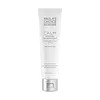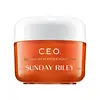What's inside
What's inside
 Key Ingredients
Key Ingredients

 Benefits
Benefits

 Concerns
Concerns

 Ingredients Side-by-side
Ingredients Side-by-side

Titanium Dioxide 3.85%
Cosmetic ColorantZinc Oxide 3.12%
Cosmetic ColorantWater
Skin ConditioningC12-15 Alkyl Benzoate
AntimicrobialIsononyl Isononanoate
EmollientPrunus Armeniaca Kernel Oil
MaskingCyclopentasiloxane
EmollientGlyceryl Stearate
EmollientPEG-100 Stearate
Butylene Glycol
HumectantPentylene Glycol
Skin ConditioningCetearyl Alcohol
EmollientDimethicone
EmollientGlycine Soja Sterols
EmollientVp/Eicosene Copolymer
Avena Sativa Kernel Extract
AbrasiveGlycerin
HumectantSodium Hyaluronate
HumectantAllantoin
Skin ConditioningTocopheryl Acetate
AntioxidantHydrogenated Lecithin
EmulsifyingTetrahexyldecyl Ascorbate
AntioxidantSuperoxide Dismutase
AntioxidantUbiquinone
AntioxidantCeramide Ng
Skin ConditioningMethicone
EmollientPalmitoyl Hexapeptide-12
Skin ConditioningPEG-10 Dimethicone
Skin ConditioningCucumis Sativus Fruit Extract
EmollientCaprylic/Capric Triglyceride
MaskingTribehenin
EmollientPEG-10 Phytosterol
EmulsifyingSorbitan Stearate
EmulsifyingPolyhydroxystearic Acid
EmulsifyingAlumina
AbrasivePolysorbate 20
EmulsifyingAluminum Stearate
Cosmetic ColorantXanthan Gum
EmulsifyingCaprylyl Glycol
EmollientDisodium EDTA
Ethylhexylglycerin
Skin ConditioningPhenoxyethanol
PreservativeChlorphenesin
AntimicrobialTitanium Dioxide 3.85%, Zinc Oxide 3.12%, Water, C12-15 Alkyl Benzoate, Isononyl Isononanoate, Prunus Armeniaca Kernel Oil, Cyclopentasiloxane, Glyceryl Stearate, PEG-100 Stearate, Butylene Glycol, Pentylene Glycol, Cetearyl Alcohol, Dimethicone, Glycine Soja Sterols, Vp/Eicosene Copolymer, Avena Sativa Kernel Extract, Glycerin, Sodium Hyaluronate, Allantoin, Tocopheryl Acetate, Hydrogenated Lecithin, Tetrahexyldecyl Ascorbate, Superoxide Dismutase, Ubiquinone, Ceramide Ng, Methicone, Palmitoyl Hexapeptide-12, PEG-10 Dimethicone, Cucumis Sativus Fruit Extract, Caprylic/Capric Triglyceride, Tribehenin, PEG-10 Phytosterol, Sorbitan Stearate, Polyhydroxystearic Acid, Alumina, Polysorbate 20, Aluminum Stearate, Xanthan Gum, Caprylyl Glycol, Disodium EDTA, Ethylhexylglycerin, Phenoxyethanol, Chlorphenesin
Water
Skin ConditioningSqualane
EmollientDicaprylyl Carbonate
EmollientTetrahexyldecyl Ascorbate
AntioxidantC10-18 Triglycerides
EmollientPEG-8 Beeswax
EmulsifyingPolyglyceryl-6 Distearate
EmulsifyingTapioca Starch
Hydrogenated Vegetable Oil
EmollientPrunus Amygdalus Dulcis Oil
Skin ConditioningCitric Acid
BufferingPPG-12/Smdi Copolymer
EmollientGlycerin
HumectantCitrus Tangerina Peel Oil
MaskingSodium Acrylates Copolymer
Bisabolol
MaskingJojoba Esters
EmollientTocopherol
AntioxidantCaprylic/Capric Triglyceride
MaskingLimonene
PerfumingPhenoxyethanol
PreservativeLecithin
EmollientNylon-12
Rosa Centifolia Flower Wax
Skin ConditioningRosa Damascena Flower Wax
MaskingSodium Phytate
Cetyl Alcohol
EmollientPolyglyceryl-3 Beeswax
EmulsifyingButylene Glycol
HumectantCaprylyl Glycol
EmollientAlcohol Denat.
AntimicrobialChlorphenesin
AntimicrobialCitrus Australasica Fruit Extract
AntioxidantPolymethylsilsesquioxane
Terminalia Ferdinandiana Fruit Extract
AntioxidantButyrospermum Parkii Butter Extract
Skin ConditioningCamellia Sinensis Leaf Extract
AntimicrobialCitrus Junos Fruit Extract
Skin ConditioningCurcuma Longa Root Extract
MaskingEuterpe Oleracea Fruit Extract
Lippia Citriodora Flower Extract
PerfumingOenothera Biennis Seed Extract
Skin ConditioningRosa Canina Fruit Extract
AstringentAlteromonas Ferment Extract
Skin ConditioningBenzyl Alcohol
PerfumingSodium Hyaluronate
HumectantLinalool
PerfumingDehydroacetic Acid
PreservativeWater, Squalane, Dicaprylyl Carbonate, Tetrahexyldecyl Ascorbate, C10-18 Triglycerides, PEG-8 Beeswax, Polyglyceryl-6 Distearate, Tapioca Starch, Hydrogenated Vegetable Oil, Prunus Amygdalus Dulcis Oil, Citric Acid, PPG-12/Smdi Copolymer, Glycerin, Citrus Tangerina Peel Oil, Sodium Acrylates Copolymer, Bisabolol, Jojoba Esters, Tocopherol, Caprylic/Capric Triglyceride, Limonene, Phenoxyethanol, Lecithin, Nylon-12, Rosa Centifolia Flower Wax, Rosa Damascena Flower Wax, Sodium Phytate, Cetyl Alcohol, Polyglyceryl-3 Beeswax, Butylene Glycol, Caprylyl Glycol, Alcohol Denat., Chlorphenesin, Citrus Australasica Fruit Extract, Polymethylsilsesquioxane, Terminalia Ferdinandiana Fruit Extract, Butyrospermum Parkii Butter Extract, Camellia Sinensis Leaf Extract, Citrus Junos Fruit Extract, Curcuma Longa Root Extract, Euterpe Oleracea Fruit Extract, Lippia Citriodora Flower Extract, Oenothera Biennis Seed Extract, Rosa Canina Fruit Extract, Alteromonas Ferment Extract, Benzyl Alcohol, Sodium Hyaluronate, Linalool, Dehydroacetic Acid
 Reviews
Reviews

Ingredients Explained
These ingredients are found in both products.
Ingredients higher up in an ingredient list are typically present in a larger amount.
Butylene Glycol (or BG) is used within cosmetic products for a few different reasons:
Overall, Butylene Glycol is a safe and well-rounded ingredient that works well with other ingredients.
Though this ingredient works well with most skin types, some people with sensitive skin may experience a reaction such as allergic rashes, closed comedones, or itchiness.
Learn more about Butylene GlycolThis ingredient is an emollient, solvent, and texture enhancer. It is considered a skin-softener by helping the skin prevent moisture loss.
It helps thicken a product's formula and makes it easier to spread by dissolving clumping compounds.
Caprylic Triglyceride is made by combining glycerin with coconut oil, forming a clear liquid.
While there is an assumption Caprylic Triglyceride can clog pores due to it being derived from coconut oil, there is no research supporting this.
Learn more about Caprylic/Capric TriglycerideCaprylyl Glycol is a humectant and emollient, meaning it attracts and preserves moisture.
It is a common ingredient in many products, especially those designed to hydrate skin. The primary benefits are retaining moisture, skin softening, and promoting a healthy skin barrier.
Though Caprylyl Glycol is an alcohol derived from fatty acids, it is not the kind that can dry out skin.
This ingredient is also used as a preservative to extend the life of products. It has slight antimicrobial properties.
Learn more about Caprylyl GlycolChlorphenesin is a synthetic preservative. It helps protect a product against bacteria in order to extend shelf life. In most cases, Chlorphenesin is paired with other preservatives such as phenoxyethanol and caprylyl glycol.
Chlorphenesin is a biocide. This means it is able to help fight the microorganisms on our skin. It is also able to fight odor-releasing bacteria.
Chlorphenesin is soluble in both water and glycerin.
Studies show Chlorphenesin is easily absorbed by our skin. You should speak with a skincare professional if you have concerns about using Chlorphenesin.
Learn more about ChlorphenesinGlycerin is already naturally found in your skin. It helps moisturize and protect your skin.
A study from 2016 found glycerin to be more effective as a humectant than AHAs and hyaluronic acid.
As a humectant, it helps the skin stay hydrated by pulling moisture to your skin. The low molecular weight of glycerin allows it to pull moisture into the deeper layers of your skin.
Hydrated skin improves your skin barrier; Your skin barrier helps protect against irritants and bacteria.
Glycerin has also been found to have antimicrobial and antiviral properties. Due to these properties, glycerin is often used in wound and burn treatments.
In cosmetics, glycerin is usually derived from plants such as soybean or palm. However, it can also be sourced from animals, such as tallow or animal fat.
This ingredient is organic, colorless, odorless, and non-toxic.
Glycerin is the name for this ingredient in American English. British English uses Glycerol/Glycerine.
Learn more about GlycerinPhenoxyethanol is a preservative that has germicide, antimicrobial, and aromatic properties. Studies show that phenoxyethanol can prevent microbial growth. By itself, it has a scent that is similar to that of a rose.
It's often used in formulations along with Caprylyl Glycol to preserve the shelf life of products.
Sodium Hyaluronate is hyaluronic acid's salt form. It is commonly derived from the sodium salt of hyaluronic acid.
Like hyaluronic acid, it is great at holding water and acts as a humectant. This makes it a great skin hydrating ingredient.
Sodium Hyaluronate is naturally occurring in our bodies and is mostly found in eye fluid and joints.
These are some other common types of Hyaluronic Acid:
Learn more about Sodium HyaluronateTetrahexyldecyl Ascorbate (THD) is a stable and oil-soluble form of Vitamin C.
THD is special in that it has the ability to travel deeper into skin than traditional ascorbic acid while maintaining the same skin benefits (double win!).
Because it’s oil-soluble, THD dives deep into your skin’s fatty layers (think ceramides and cholesterol) to fight off the kind of free radicals that mess with your skin barrier. This makes it a great pair with water-based vitamin C (ascorbic acid) that mainly works on the surface.
Even at just 0.1%, THD is already showing great antioxidant activity. When used up to 2%, it helps keep your skin happy and calm, especially when it’s stressed from pollution or sun.
Want to fade dark spots or tackle hyperpigmentation? You’ll want 5% or more. Pairing it with brightening buddies like niacinamide or licorice root gives even better results. One study even used 30% THD with other brighteners and saw real results on stubborn discoloration, even in melasma-prone skin.
A note on THD: It’s has a slightly silky, oily texture and usually shows up colorless or pale yellow (though the exact shade can vary by supplier).
While you can sneak it into water-based formulas, it really shines when paired with silicones or oils, which help your skin soak it up better.
THD is pretty stable, but it’s still vulnerable to degradation like ascorbic acid. Too much light or heat (above 113°F / 45°C) can break it down over time. Go for dark and opaque packaging that keeps it safe and shady!
Read more about other types of Vitamin C:
Learn more about Tetrahexyldecyl AscorbateWater. It's the most common cosmetic ingredient of all. You'll usually see it at the top of ingredient lists, meaning that it makes up the largest part of the product.
So why is it so popular? Water most often acts as a solvent - this means that it helps dissolve other ingredients into the formulation.
You'll also recognize water as that liquid we all need to stay alive. If you see this, drink a glass of water. Stay hydrated!
Learn more about Water